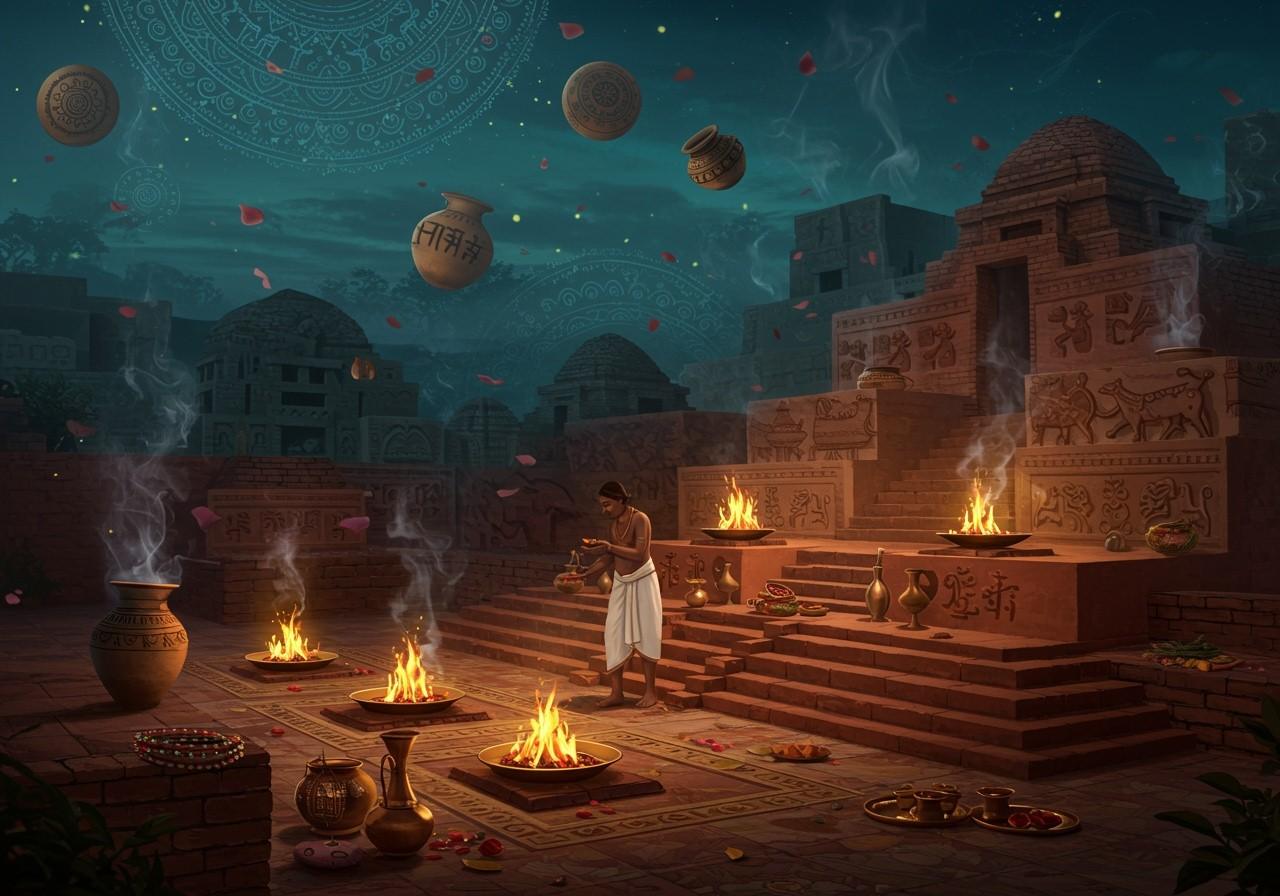
The Indus Valley Civilization, a Bronze Age marvel spanning from 3300 BCE to 1300 BCE, left an indelible mark on South Asia. Kalibangan, a key city flourishing around 2900 BCE, stands as a testament to their ingenuity, with its planned layout, unique fire altars, and the world’s earliest known ploughed field. This article delves into Kalibangan’s spiritual importance, the Indus Valley people’s religious practices, and the symbolism woven into their artifacts.
Kalibangan’s Link to Early Hinduism
Kalibangan offers compelling connections between the Indus Valley Civilization and the genesis of Hinduism. The geometric patterns and sacred symbols adorning pottery and seals echo early Hindu iconography. The presence of fire altars hints at ritualistic practices akin to Vedic sacrifices. The city’s architectural design suggests a societal structure that may have shaped later Hindu temple architecture. Water bodies within Kalibangan, such as wells and baths, mirror the significance of water in Hindu rituals. Furthermore, agricultural fertility rituals practiced in the Indus Valley appear to have continued into later Hindu traditions. Similarities between Indus Valley deities and early Hindu gods, like proto-Shiva figures, further strengthen this connection. Animals, particularly the bull, hold a prominent position in both Indus Valley and Hindu traditions.
Ritualistic Practices in the Indus Valley
The inhabitants of Kalibangan engaged in a rich tapestry of ritualistic practices. Fire altars served ceremonial purposes, potentially including sacrificial rites. Burial customs and grave goods suggest a belief in the afterlife. Large public areas and shared altars point towards communal religious activities. Ritual bathing, as evidenced by the Great Bath of Mohenjo-Daro and smaller baths in Kalibangan, played a vital role. Specialized artifacts and structures suggest the presence of priestly figures who likely conducted these rituals. Archaeological findings indicate the prevalence of seasonal and agricultural festivals. Amulets and charms discovered at the site reveal a belief in supernatural forces and their power to protect and bless.
Symbolism in Kalibangan Artifacts
The artifacts unearthed at Kalibangan are imbued with profound symbolism. Intricate designs on pottery showcase geometric patterns and animal motifs, possibly carrying religious meaning. Seals, employed for both economic and spiritual purposes, bear images of deities, animals, and mythological scenes. Specific materials, such as terracotta and stone, were chosen for crafting ritual objects. The unicorn motif on Indus Valley seals may hold religious connotations. Depictions of plants and trees on artifacts suggest their sacred status. Jewelry and ornaments, as suggested by burial findings, were likely used in religious ceremonies. Artistic representations hint at the use of musical instruments, like drums and stringed instruments, in ritualistic practices.
Poojn.in: Connecting You to Ancient Traditions
Poojn.in, India’s leading cultural goods and services store, offers a wide selection of products to support your spiritual journey, echoing the rich traditions of Kalibangan and the Indus Valley Civilization. Explore our collection and enrich your connection to this ancient heritage.
- Traditional Incense and Dhoop: Experience the sanctity of ancient rituals with pure Guggul Dhoop, traditional incense sticks crafted from natural aromatic materials, and premium dhoop cones available at poojn.in.
- Puja Essentials: Prepare for sacred ceremonies with complete puja thalis in traditional designs, pure copper and brass items, and authentic diya and agarbatti stands available at poojn.in. We offer a wide variety of items to enhance your puja experience.
- Sacred Items for Worship: Deepen your connection with the divine through carefully selected ritual items, quality-checked materials for ceremonies, and traditional bells and conch shells available at poojn.in. Each piece is chosen for its authenticity and spiritual significance.
Conclusion
Kalibangan provides a captivating window into the spiritual life of the Indus Valley Civilization. The evidence discovered, from pottery and seals to architectural layouts, reveals intriguing links to early Hindu practices. Rituals centered around fire altars, water bodies, and communal spaces reflect a deep-seated tradition of worship and ceremony. Symbolic artifacts, including depictions of proto-Shiva figures and sacred animals, underscore the continuity of religious beliefs from the Indus Valley to later Hinduism. Understanding Kalibangan’s spiritual legacy allows us to appreciate the intricate history of Hindu rituals and practices. As we navigate the modern world, it’s crucial to honor and preserve these ancient traditions that continue to shape our cultural identity. By exploring and respecting our past, we can ensure the spiritual essence of our heritage thrives for generations to come.
Visit our blog for more insightful articles.
Learn more about Lord Shiva.
Discover Lord Brahma.


